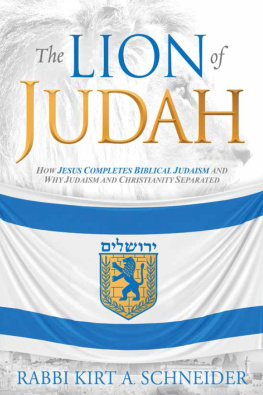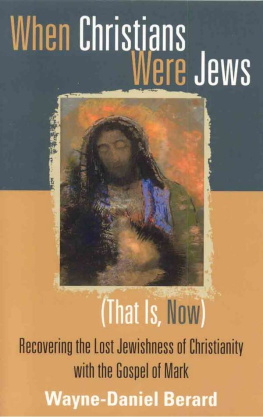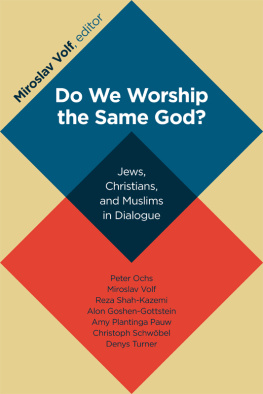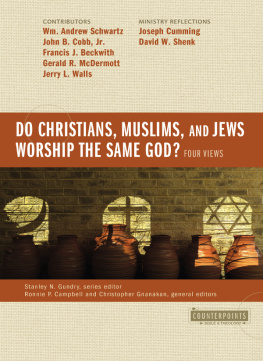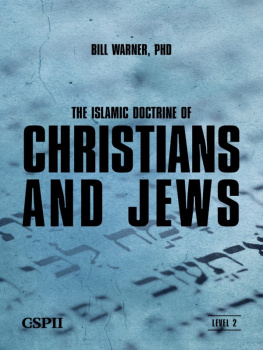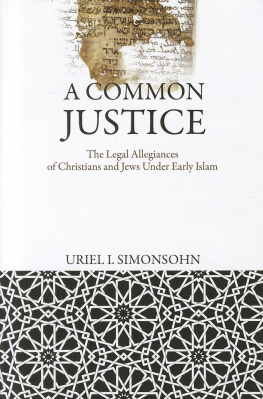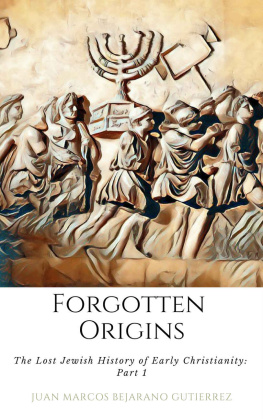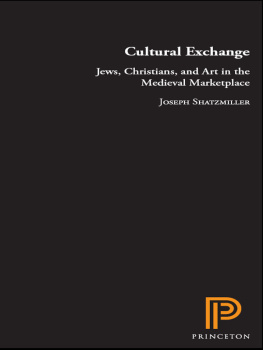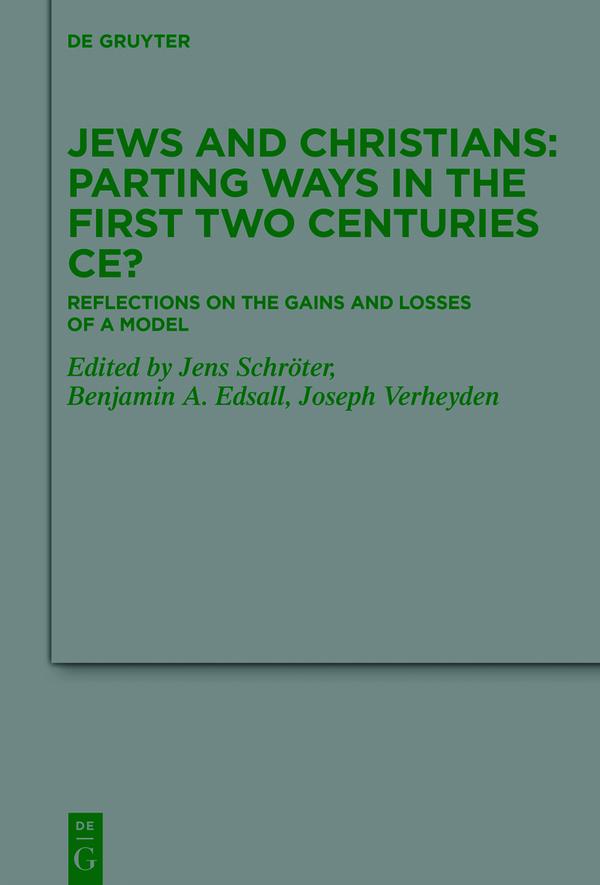Beihefte zur Zeitschrift fr die neutestamentliche Wissenschaft
Edited by
Matthias Konradt
Judith Lieu
Laura Nasrallah
Jens Schrter
Gregory Sterling
Volume
ISBN 9783110742138
e-ISBN (PDF) 9783110742213
e-ISBN (EPUB) 9783110742244
Bibliographic information published by the Deutsche Nationalbibliothek
The Deutsche Nationalbibliothek lists this publication in the Deutsche Nationalbibliografie; detailed bibliographic data are available on the Internet at http://dnb.dnb.de.
2021 Walter de Gruyter GmbH, Berlin/Boston
Introduction
Jens Schrter
Benjamin A. Edsall
Joseph Verheyden
The contributions in this volume go back to a conference held in December 2019 at the Faculty of Theology of Humboldt University Berlin. The conference was the initiation of a larger project on Jews and Christians in the First Three Centuries CE, jointly organized by Australian Catholic University, which graciously sponsored the meeting, Catholic University Leuven and Humboldt University Berlin.
We want to thank Konrad Schwarz (Berlin) and Charlotte von Schelling (Regensburg) for their cooperation in preparing the manuscript, including many helpful suggestions which have contributed substantially to the publication of the present volume. Alexandra Priesterath and Janina Skra did an excellent job in preparing and hosting the Berlin meeting, for which we are very grateful. Last, but not least, we would like to thank the publishing house Walter de Gruyter, especially Alice Meroz and Sabina Dabrowski, for friendly and reliable collaboration during the publication process.
The idea of the Berlin conference was neither to defend nor to refute the model of the parting(s) of the ways. Instead, the well-known metaphor which is still used today, served as a starting point to reflect on the relationship of Jews and Christians in the first three centuries.
Challenging the Idea of Parting Ways
The relationship between Jews and Christians in the first three centuries CE belongs to the most burning issues in current scholarship. Already the terminology for an adequate historical description is disputed. It may be questioned whether it is appropriate to use terms such as Christians and Christianity for the earliest years of the Jesus movement and the Christ groups of the Mediterranean world, as there was a great variety of such groups in the early period.
These observations have called into question the model of a parting of the ways, used some thirty years ago by the late James Dunn, to describe the relationship between Christianity and Judaism in the earliest period. With this metaphor Dunn wanted to describe the historical processes that can be traced back to the Hellenists and Paul and came in its decisive stage in the period between 70 and 135.
In recent years, scholarship has gravitated toward replacing the idea of a parting or several partings with other models. Thus, in the first centuries CE we are facing not two religious movements, but diverse groups of Jesus followers with different social and religious crossovers and interactions.
The questioning of the model of a parting (or several partings) of the ways has even led to the counter-formulation that the ways of Judaism and Christianity never parted. Nevertheless, it is important to be aware of the terminological pitfalls which attend descriptions of the complex reality of Christ groups and Synagogue communities in the Roman Empire of the first three centuries CE. Terms or metaphors can emphasize commonalities or differences between Jews and Christians; they can simplify complex historical realities; they evoke the idea of a targeted process that inevitably resulted in a bifurcation of Judaism and Christianity as separated religious and social entities; or they can highlight that Jews and Christians did not simply part from each other, but formed groups with various perspectives on the authoritative Scriptures of Israel, the meaning of the Torah and the salvation of humankind, the relationship of this world to the otherworld, etc.
Summary of the Individual Chapters
Given the broad, complex, and shifting nature of social and theological identities among early Jews and Christians, the contributions in this volume, far from claiming to present a complete survey, offer soundings in the ocean of early Christian and Jewish interactions. In the course of the book, the chapters progress from a focus on broader conceptual and terminological matters to discussions of particular writers, to close with a series of investigations oriented geographically around Asia Minor, Rome and Alexandria.
Christoph Markschies opens the collection fittingly with an extended reflection on the usefulness of road metaphors in modeling early Jewish-Christian relations. In tracing the history of their use, he notes that the simplicity of the metaphor is usually not matched by simplicity in the available material. He shows that, even by the time of John Chrysostom at the end of the 4th century, the rhetoric of separation itself provides evidence for ongoing interaction and shared religious observance between Jews and Christians. Identities are complex, at both institutional and individual levels, and this complexity is also seen in most of the contributions to the book.
Anders Runesson and Jan Bremmer seek to illuminate the complexity of the issues by looking at socio-institutional and terminological aspects of Jewish-Christian relations, respectively. Runesson argues, provocatively, that the entire debate about the parting (or partings, or lack thereof) is based on a simplistic, monolithic understanding of the role of the synagogue and a confusion between different groups of Christ associations: non-Jewish Christ associations never shared an institutional context with rabbinic Judaism. For his part, Bremmer traces the development in the use of the terms Ioudaismos and Christianismos from 2 Maccabees (for the former) through the early 3rd century. It emerges that these terms signify a way of life in that period and that, at least in Christian sources, they are developed in tandem, with their use signifying distance between Jewish and Christian communities to different degrees in different places.
After these conceptual and terminological discussions, the following six chapters turn to texts or figures who have in the past been identified as clear witnesses to the parting, ranging from Paul to Justin Martyr. Jens Schrters investigation of Paul approaches the question in two principal ways, first by inquiring into Pauls own self-presentation and his articulation of the relation between Christ-believers and non-believing Jews and, second, by addressing practical considerations related to Torah observance and the life of these Christian communities. Similarly, Matthias Konradt organizes his chapter on the Gospel of Matthew within or outside of Judaism? around the twin poles of evidence for its strong and ongoing connections with contemporary Judaism and its interest in the inclusion of gentiles qua gentiles. In the case of Acts, Kylie Crabbe emphasizes the consistently hybrid identity of the various literary characters Timothy, Apollos, Paul et al. When one takes the complex of overlapping identities together with the literary aspect of the work, where characters fulfill particular plot functions without unambiguous external, historical referents, it becomes increasingly clear that the possibility of holding together multiple identities is what enables the inclusion of Jewish and Gentile believers within the same community. For all three authors, the question of inside or outside operates on too binary a logic to adequately address the historical situations.


